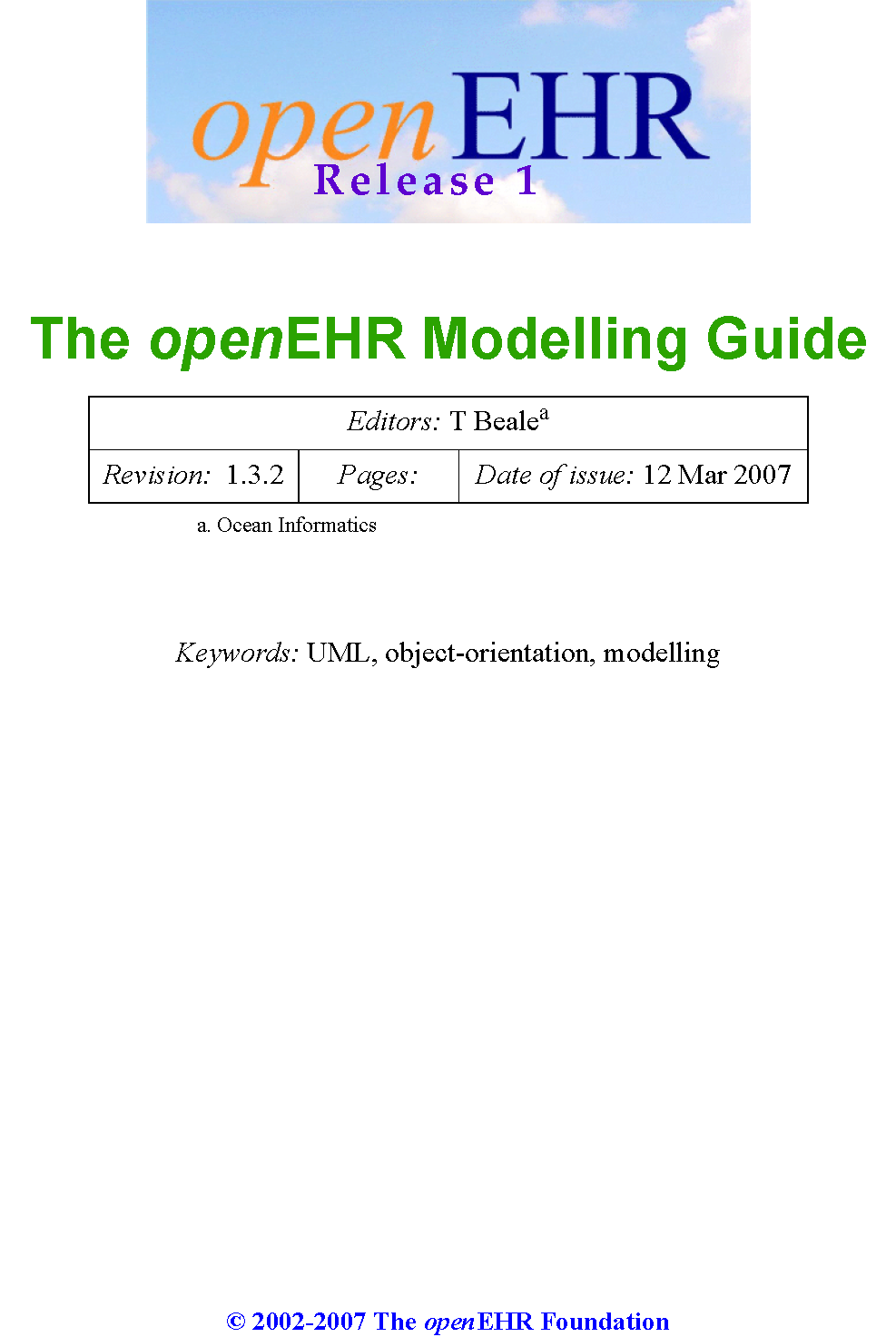
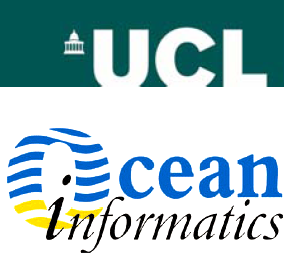

The openEHR Foundation is an independent, non-profit community, facilitating the sharing of health records by consumers and clinicians via open-source, standards-based implementations.
Founding David Ingram, Professor of Health Informatics, Chairman CHIME, University College London
Founding Dr P Schloeffel, Dr S Heard, Dr D Kalra, D Lloyd, T Beale Members
email: info@openEHR.org web: http://www.openEHR.org
Rev 1.3.2
Amendment Record
| Issue | Details | Who | Completed |
|---|---|---|---|
| R E L E A S E 1.0.1 | |||
| 1.3.2 | Minor modifications and updates to tooling description. | T Beale | 12 Mar 2007 |
| 1.3.1 | Added inheritance diagram section. | T Beale | 08 Mar 2006 |
| R E L E A S E 1.0 | |||
| 1.3 | Added class colour scheme. | T Beale | 24 Dec 2005 |
| R E L E A S E 0.95 | |||
| 1.2.1 | Added section on functions and anchored types. | T Beale | 24 Feb 2005 |
| 1.2 | Added section on tooling. | T Beale | 14 Feb 2005 |
| R E L E A S E 0.9 | |||
| 1.1.1 | CR-000041. Visually differentiate primitive types in openEHR documents. CR-000013. Rename key classes, according to CEN ENV 13606. Add explanation of qualified associations, existence, cardinality. | D Lloyd, D Kalra, T Beale | 04 Oct 2003 |
| 1.1 | Kestral Australia review. | G Grieve | 08 Mar 2003 |
| 1.0 | Adapted from openEHR EHR Reference Model document | T Beale | 10 May 2002 |
The work reported in this paper has been funded in part by the Cooperative Research Centres Program through the Department of the Prime Minister and Cabinet of the Commonwealth Government of Australia, by Ocean Informatics, Australia, and by the CHIME department, University College London.
Date of Issue:12 Mar 2007 Page 2 of 19 Author: T Beale
The openEHR Modelling Guide Introduction Rev 1.3.2
This document describes modelling method and tools of openEHR. It explains the usage of UML, how to read the openEHR specifications. The intended audience includes:
• Software development organisations using openEHR.
The openEHR Foundation provides specifications of health information systems and interoperability mechanisms in the form of formal, object-oriented models. These models are expressed in the OMG Unified Modelling Language (UML), along with detailed tabular descriptions. A formal textual expression is used to verify all models, ensuring that openEHR specifications are more than just paper. At the coarsest scale, the models are designed according to the ISO reference model for open distributed processing (RM/ODP). The openEHR models are divided into the Reference Model (RM), containing the information viewpoint, the Service Model (SM), containing the computational viewpoint, and the Archetype Model (AM), containing the formalisms for domain models, known as archetypes.
The models are a suitable starting point for system and interoperability software. Expressions in various implementation technologies are supplied by openEHR, known as Implementation Technology Specifications (ITSs). These are generated from the formal textual primary expression of the models.
Author: T Beale Page 3 of 19 Date of Issue:12 Mar 2007
© 2002-2007 The openEHR Foundation email: info@openEHR.org web: http://www.openEHR.org
The openEHR Modelling Environment The openEHR Modelling Guide Rev 1.3.2
Since the primary users of the formal specifications in health information standards are software developers and information systems builders, it is crucial that the models presented are comprehensible and implementable by technical people. To ensure comprehensibility, the OMG standard UML
2.0 diagramming language has been used for graphical models. Detailed formal specifications of all classes are given, including class invariants and function pre- and post-conditions.
In order to ensure implementability, a tool-based environment is used for representation and manipulation of the models. The general approach is to have a single, authoratative “source” for any given artifact, and to use purpose-built converters to generate usable “views” of the source. The main way this is applied is that the core information and service model specifications (IMs and SMs) of the Reference Model are fully defined in an object-oriented formalism, with implementation technology specifications (ITSs) being generated as views. For example, the XML-schema, Java interface classes, C# interface classes, and other computable views for the EHR can be generated from the primary EHR model, which is expressed in formal textual UML 2.0-compliant semantics.
Model verification environment UML Tool Environment
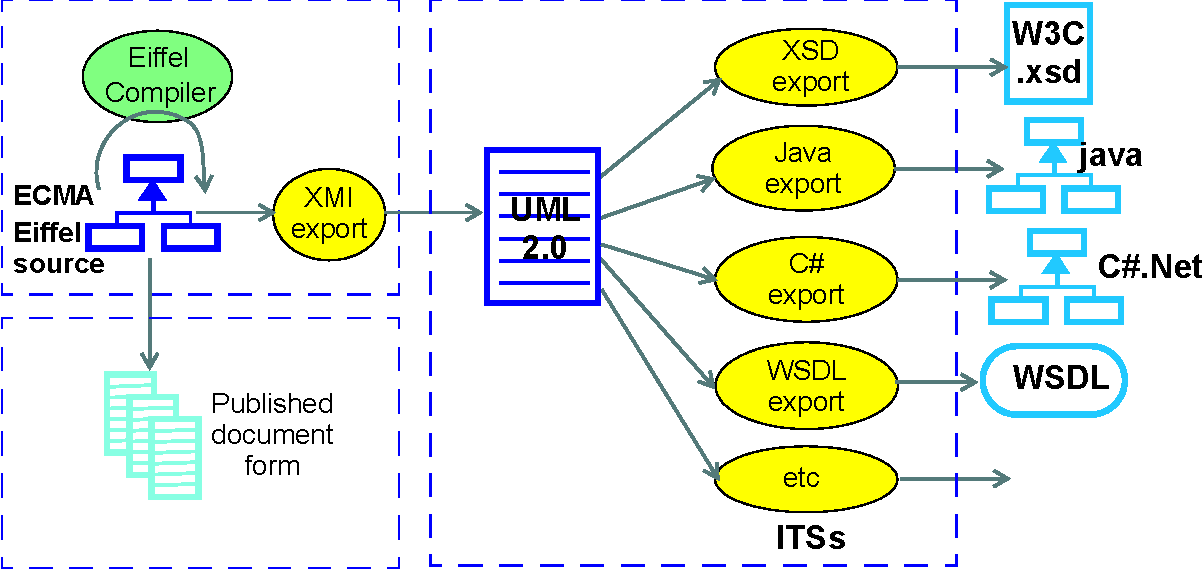
Publishing environment
FIGURE 1 openEHR modelling environment
The primary expression of all object-oriented openEHR models is currently the ECMA-standardised Eiffel language (ECMA Eiffel page ), as this the only textual formalism that closely approximates UML 2.0, and has tools available for it (GPL version available, see http://www.eiffel.com). The use of the Eiffel tools permit the core models to include all possible object-oriented semantics, including classes, attributes, functions, procedures, pre- and post-conditions, class invariants, multiple inheritance, genericity (“template” classes), agents (“delegates”), within a fully object-oriented type system (i.e. even basic types such as integer are instances of classes). Invariants are probably the single most important element of class specifications in any object model, since they indicate to the developer the valid instance structures in a system (for example, if a list attribute must be present, and if it is, whether the list can be empty and so on). All of these semantics can be validated, ensuring that the published specifications are much more than “just paper”, as is unfortunately common with many well-known published standards.
Date of Issue:12 Mar 2007 Page 4 of 19 Author: T Beale
© 2002-2007 The openEHR Foundation email: info@openEHR.org web: http://www.openEHR.org
The openEHR Modelling Guide The openEHR Modelling Environment Rev 1.3.2
The primary models are used as the source for the published documentary form of the specifications, generally in Adobe PDF format. There is not considered to be any semantic difference between tool-based abstract model expressions and their documentary counterparts, i.e. there is no “mapping” or “conversion”.
The primary models are also losslessly translated to a UML-2.0 compliant XML instance form, from which all other views are generated. In theory, this intermediate form should be OMG XMI, but for various practical reasons it is not: not only are XMI documents massive and impossible for humans to read, but they do not correctly include pre- and post-conditions or invariants. However, the choice of the intermediate format may change in the future - the only requirements are that it be lossless with respect to the primary specifications, and that it be acceptable and processable by its users.
Author: T Beale Page 5 of 19 Date of Issue:12 Mar 2007
© 2002-2007 The openEHR Foundation email: info@openEHR.org web: http://www.openEHR.org
Formalisms The openEHR Modelling Guide Rev 1.3.2
The openEHR models are shown in UML (Unified Modelling Language) [5] and have been formally validated using the Eiffel language, which (strangely) is still one of the only reliable tools for specifying and fully validating object-oriented models. UML is an industry-standard modelling language, which has been formally defined by the OMG. The openEHR models make heavy use of two powerful UML semantics, namely:
straint Language, OCL) The notation used in this document follows the UML version 2.0 (see [5]). The following sections describe the major semantic constructs in the class diagrams in this document. Refer to Meyer [8] for a definitive guide to object-oriented semantics.
A collection of related classes, typically corresponding to one or more business objects, and grouped for convenient management of development. Packages may be nested hierarchically. Indicated graphically by a named blue rectangle containing classes.
The primary construct in object-oriented modelling and software development. A class defines objects in terms of behaviour and state, or in more technical terms, routines and attributes. The class definition is the template for creating objects at runtime, which are instances of the class.
Inheritance is a relationship between classes in which the definition of the descendant (inheriting class) is based on the ancestor. The descendant may change the ancestor’s definition in certain ways, according to the rules of the formalism. Inheritance is not normally visible at runtime as a relationship between objects. A number of meanings can be assigned to inheritance relationships, including:
Association is a relationship between classes which describes a runtime relationship between objects. Its cardinality may be single (1:1) or multiple (1:N).
A particular kind of association between classes indicates the logical part-of relationship. There are two recognised variants of this, namely composition, or containment-by-value, and aggregation meaning a logical part-of relationship. The use of these different types of association in the model is detailed below.
Date of Issue:12 Mar 2007 Page 6 of 19 Author: T Beale
© 2002-2007 The openEHR Foundation email: info@openEHR.org web: http://www.openEHR.org
| The openEHR Modelling Guide | Formalisms | |
|---|---|---|
| Rev 1.3.2 | ||
| 3.2 | Other Alternatives | |
Numerous alternatives were considered both in the original GEHR project, and for openEHR, including the following:
OMG IDL: the OMG’s IDL language lacks assertions and generic types, and its type model is inconsistent (basic “types” are not the same as constructed types, due to the influence of C); Rumbaugh/Booch/etc notations: none of these notations are formal, and all lack assertions. In any case, they have been superseded by UML; SGML/XML: SGML is overly complex, and very document-oriented.
XML-schema: not well adapted to information modelling (cf information representation) because it is purely data-oriented, and missing a number of important semantics, namely assertions, generic types and multiple inheritance.
Z, Object Z, B: these are worthy of future consideration. Their use now is prevented mainly by a lack of industrial strength tools.
Author: T Beale Page 7 of 19 Date of Issue:12 Mar 2007
© 2002-2007 The openEHR Foundation email: info@openEHR.org web: http://www.openEHR.org
Modelling Guide The openEHR Modelling Guide Rev 1.3.2
One crucial point to understand about modelling is that the semantics of all definitions in a model constitute statements about the informational (or behavioural) entities defined by the relevant classes, and no more. Many modellers make the mistake of entering into torturous discussions about the semantics of real world objects based on the arrangement of classes or relationships in a model, when in fact the argument should be the other way around - any model is a formalisation and abstraction, potentially of real world entities, and its meaning does not extend beyond itself. Thus, any concept in a model, such as defined by the type QUANTITY should not be understood as being a description of quantities in the real world, but a formal, abstract model of a concept called “quantity” as agreed by the modellers.
Class names are in upper case, with underscore separators, enabling them to be easily identified and read. In almost all cases, the full english word has been used. Class feature names (i.e. attribute and method names) are in lower case, underscore separated.
This style choice may surprise some developers, and has been done in purpose for a number of reasons:
The names used in the abstract specifications are transformed by tools into the preferred idiom of each target formalism; the rules for doing so are described in each ITS.
All names have been chosen with implementors and other people in mind who will deal with technical modelling, rather than users. In almost all cases, users will never see the names used in the reference or archetype models. The exception is archetype editor tools which would normally show the class names of instances of the archetype model which are being created; it is assumed that users of this tool will have a basic technical understanding of the reference and archetype models.
Three classes of operator are used:
Date of Issue:12 Mar 2007 Page 8 of 19 Author: T Beale
© 2002-2007 The openEHR Foundation email: info@openEHR.org web: http://www.openEHR.org
| The openEHR Modelling Guide | Modelling Guide | |
|---|---|---|
| Rev 1.3.2 | ||
| 4.4 | Types | |
The reference model can be thought of as consisting of a number of classes which fulfill one of two purposes. The first category includes those which represent concretely-modelled concepts like “revision history entry” or “transaction”, while the second includes those whose job it is to represent generic data structures, used to express clinical data whose specific form is defined by archetypes, rather than by the reference model. The general form of the latter can best be understood as structures of name/value pairs, where all nodes in the structure have names, and leaf nodes have values as well. There are accordingly two kinds of “datatypes” used in the model: one for the attributes of all classes, and the other for the values in the clinical name/value structures. These latter are known as “data value types”, whereas the former are known as “attribute types”. Instances of data value types are the only allowable values in the generic information structures.
In addition to types defined in the model, a number of basic types are assumed in the modelling formalism, which are globally understood in the same (or compatible) ways in all implementation formalisms. These are:
-Character (members of a character set) -String (strings of printable characters) -Integer (integer numbers) -Real (real numbers) -Double (double precision floating point real numbers) -Boolean (two-valued entities) -Array<T> (physical container of items indexed by number) -List<T> (implied order, non-unique membership) -Set<T> (no order, unique membership)
Data value types are characterised by being explicitly modelled and inheriting from the abstract class DATA_VALUE. The names of all of these types are prefixed with “DV_” to differentiate them from types of the same names which may occur in particular implementation technologies, thus DV_DATE rather than DATE and so on. Types which are notionally one of the standard basic types have a specific model. For example, the notional “string” type is modelled as the data value type DV_PLAIN_TEXT.
Data value types are the only types which can be used as data values, e.g. as the type of the ELEMENT.value attribute in the openEHR EHR reference model, or other similar places where the type DATA_VALUE is specified.

FIGURE 2 rm.data_structures.representation Package
Author: T Beale Page 9 of 19 Date of Issue:12 Mar 2007
© 2002-2007 The openEHR Foundation email: info@openEHR.org web: http://www.openEHR.org
Modelling Guide The openEHR Modelling Guide Rev 1.3.2
Types which can be used for other attributes in model classes include any standard basic type, or any of the data value types. For example, if a string is needed, the class STRING may be used, unless special features of DV_PLAIN_TEXT are required. If a date/time is needed however, since there is no guaranteed standard type for this, the data value type DV_DATE_TIME must be used.
Existence of attributes is indicated by brackets after the attribute name inside a class box. Possible values are: [0..1], [1], meaning optional and mandatory, respectively. For attributes of container types such as List<T>, existence of the whole container is shown the same way. Cardinality of the container is shown by including the container type explicitly.
PERSON
name [1]: String address [0..1]: List<String>
FIGURE 3 Attribute Existence and Cardinality
The inheritance relationship between classes indicates that one class is the descandant of another, termed the ancestor. Two kinds of inheritance are used in the openEHR models, both readily available in all object-oriented formalisms. These are standard specialisation or “is-a” inheritance, implying type substitutability, and facility inheritance, whereby the descendant class is simply using the facilities of the inherited class. To make clear the distinction in the UML diagrams, specialisation inheritance is indicated using unbroken grey lines, while facility inheritance is indicated using dotted lines, as shown in the following example.

FIGURE 4 rm.data_types.quantity.date_time Package
Relationships between classes in the reference model are of three logical types, described below.
Composition indicates the part/sub-part relationship where the sub-part can have no meaningful existence outside of the whole, or, put another way, the lifetime of the part is controlled by the whole. For example, in the openEHR EHR RM, the class COMPOSITION has as a subpart ACCESS_CONTROL,
Date of Issue:12 Mar 2007 Page 10 of 19 Author: T Beale
© 2002-2007 The openEHR Foundation email: info@openEHR.org web: http://www.openEHR.org
The openEHR Modelling Guide Modelling Guide Rev 1.3.2
illustrated in FIGURE 5 . All objects contained within a single “business object”, i.e. Strings, Integers and other leaf types are always related to the containing object by composition.
In UML, composition is indicated by a black diamond on the class representing the whole. A “part” object can only be in a composition relationship with one “whole” object, i.e. a given instance cannot be part-of multiple wholes.
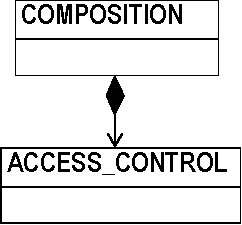
| CODED_TERM |
|---|
| rubric: String concept_code: String |
FIGURE 5 Examples of Composition
Semantically, composition corresponds to physical containment by value. Movement or deletion of the whole causes movement or deletion respectively of the part.
Aggregation indicates a logical part/sub-part relationship, where the sub-part can meaningfully exist on its own, i.e. does not need to be deleted if the parent whole is deleted. Consider by way of example the relationship between HEALTH_CARE_FACILITY and HEALTH_CARE_PROFESSIONAL illustrated in FIGURE 6. The difference in semantics with respect to composition is that aggregation parts and wholes represent business objects (e.g. HOSPITALand PERSON), whereas the part objects of composite relationships represent fine-grained constituents inside a business object (e.g. PERSON and PERSON_NAME).
HEALTH_CARE_FACILITY
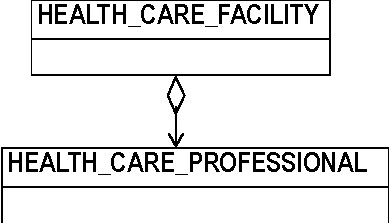
FIGURE 6 Example of Aggregation
In UML, aggregation is indicated by a white diamond on the class representing the whole and a key shown on the part, meaning that the whole class contains a key referring to the part class. Movement or deletion of the whole may occur without movement or deletion of the part.
A sensible definition of the semantics of aggregation has historically been, and remains, problematic for many modellers. Various books on UML including “UML Distilled” [5], and indeed the authors of UML themselves have noted the confusion1, and done little to clear it up. Consequently, in some publications, the aggregation relationship has the semantics of allowing a “part” to be a part-of more than one whole. We see this as an error for a number of reasons.
1. Jim Rumbaugh says of aggregation “think of it as a modelling placebo” (Rumbaugh, Jacobsen and Booch 1999) [3]. Martin Fowler calls it “one of my biggest betes noires”. Clearly, aggrega tion is not well understood by the “experts” [5].
Author: T Beale Page 11 of 19 Date of Issue:12 Mar 2007
© 2002-2007 The openEHR Foundation email: info@openEHR.org web: http://www.openEHR.org
Modelling Guide The openEHR Modelling Guide Rev 1.3.2
Consequently, in this document aggregation semantics are defined such that a “part” object can only be in a aggregation relationship with one “whole” object, i.e. a given instance cannot be part-of multiple wholes.
Association indicates any other kind of relationship in which instances of both classes are completely meaningful in themselves. Indicated by no diamond in UML.
One kind of association which occurs quite commonly is the “qualified association”. In contrast with normal associations which are “direct” (i.e. object to object), qualified associations are by symbolic reference, where the reference is in the form of an attribute value from the target class. FIGURE 7 illutrates the qualified asscociation, and shows an equivalent single class below it. The qualified association is most commonly used when objects of the target class will each have a unique id which can be referenced from elsewhere, in the manner of a primary/foreign key in relational systems (here the foreign key is the attribute bar_id: String in the class Foo.

FOO
bar_id: String
FIGURE 7 Qualified Association
1. This is well known as the “flyweight” pattern described in [6]. In the UML diagram for this pattern, an aggregation relationship appears between a flyweight-factory and the flyweight (shared) object; associations appear between the logical “owners” and the factory-generated flyweights)
Date of Issue:12 Mar 2007 Page 12 of 19 Author: T Beale
© 2002-2007 The openEHR Foundation email: info@openEHR.org web: http://www.openEHR.org
The openEHR Modelling Guide Modelling Guide Rev 1.3.2
Functions are understood in openEHR in the object-oriented sense as “computed features having a return type, and not causing side-effects in the object on which they are called”. Functions are used in various places to define relevant interface, to support the expression of invariants, or to express computation of derived properties, such as extracting the logical pieces from a URI string.
An object-oriented feature used sometimes in the openEHR specifications is that of “anchored types”. An example of such a type is shown in the following UML.
| ORDERED |
|---|
| infix ‘<’ (other: like Current): Boolean |

FIGURE 8 pseudo-UML for Anchored Types
In this figure, an infix function ‘<‘ is defined on the abstract type ORDERED. The signature has the parameter other, of type “like Current”. This syntax has been adopted from the Eiffel language because it is so useful in specification. Its effect is to say that in every subtype of ORDERED there is a function ‘<‘ whose other argument is of the same type as the subtype - with no actual repeated definitions required to do this. This clearly saves on code, reduces errors of repetition. Although it is not available in UML, or in many languages, it is used in the specifications to reduce the repetition, and improve clarity. Mapping to implementation formalisms is easy: simply define the initial signature as having the same type as the type on which it is defined (ORDERED in this above example), and redefine the signature appropriately down the inheritance tree.
Constraints are written in a order predicate logic based on the OMG’s Object Constraint Language (OCL), with some differences due to problems in the current definition of OCL.
The keywords used are:
The various kinds of constraints together form the “contract” of a class, that is the conditions under which its instances interact with instances of other classes (including itself). The following sections describe the three constraint types. See Meyer [8] and Kilov [7] for an explanation of contracts.
Author: T Beale Page 13 of 19 Date of Issue:12 Mar 2007
© 2002-2007 The openEHR Foundation email: info@openEHR.org web: http://www.openEHR.org
Modelling Guide The openEHR Modelling Guide Rev 1.3.2
Pre-conditions are introduced with the keyword require, and consist of a first-order predicate logic expression evaluating to True or False. A precondition represents the truth condition which must be upheld by the caller of a routine to ensure the correct functioning of the routine, i.e. it is a condition assumed to be true by the routine. If a pre-condition is violated, the caller is in the wrong.
Post-conditions are introduced with the keyword ensure, and consist of a first-order predicate logic expression evaluating to True or False. A post-condition represents the truth condition which must be upheld by a routine, i.e. it is a condition guaranteed to be true by the routine to the caller. If a post-condition is violated, the called routine is in the wrong.
Invariants consist of first order predicate logic statements which apply to the whole class. The meaning is that for every instance of the class, the condition is true at all times, apart from mid-execution of a routine. In other words, object invariants are always true at the points in time when they are accessible to other objects - including prior to calling a routine, and upon exit. If an invariant fails, there is an error in the design of the class. Invariants must be satisfied upon completion of any creation routine.
The type Any is assumed as the parent type of all other types, and is the type on which basic operators of equality and assignment are defined. See the Support Reference Model for details.
The following special instances are indentified in constraints.
Date of Issue:12 Mar 2007 Page 14 of 19 Author: T Beale
© 2002-2007 The openEHR Foundation email: info@openEHR.org web: http://www.openEHR.org
The openEHR Modelling Guide Class Descriptions Rev 1.3.2
Classes in the openEHR models are formally described in tabular form. Three colour schemes are used, as follows:
Cyan: reference model classes
Light green: archetype model classes Reference model classes are defined in the form shown below. The various meanings of each section are indicated in this example table.
| CLASS | CLASS_NAME | |
|---|---|---|
| Purpose | Description of purpose of class in model and information based on it. | |
| Use | Particular uses of class in the model, or instances of the class in data. | |
| MisUse | Potential expected misuses of the class, usually based on common misuses or misconceptions of the name of the class. | |
| CEN | Correspondence to CEN ENV 13606 part 1 - part 4 concepts. These standards were published by CEN in 2000, and can be found on http://www.centc251.org. | |
| Synapses | Correspondence to concepts in the Synapses, SynEx and EHCR-support Action models, produced in various EC-funded (4th framework) post-original GEHR projects. Some of this work is available at http://www.chime.ucl.ac.uk. | |
| GeHR | Correspondence to Australian GEHR models as originally published on http://www.gehr.org (now defunct); see specifications at http://www.openehr.org/gehr_australia/t_aus_gehr.htm. | |
| HL7v3 | Correspondence to concepts in HL7 version 3 models, as published in various ballots at http://www.hl7.org. | |
| Attributes | Signature | Meaning |
| 0..1 | attr_1: SOME_TYPE | Description of this attribute |
| 1..1 | attr_n: SOME_TYPE | Description of this attribute |
| Functions | Signature | Meaning |
| func_1(some_args: SOME_TYPE): SOME_TYPE require precondition ensure postcondition | Description of this function | |
| func_n(some_args: SOME_TYPE): SOME_TYPE | Description of this function | |
Author: T Beale Page 15 of 19 Date of Issue:12 Mar 2007
Class Descriptions The openEHR Modelling Guide Rev 1.3.2

Class invariants. Each mandatory attribute must have an invariant of the form: Attr_1_exists: attr /= Void Other invariants may be stated. All invariants have to be true before and after calls to routines (procedures or functions) made from outside an object.
Preconditions and postconditions of functions are optional; all preconditions, postconditions and invariants are written in the first-order predicate logic used in the Eiffel language [8] , [9] (mainly because this is compilable and testable in any Eiffel tool, including the Gnu SmallEiffel com piler ).
Archetype classes are defined using tables like the following.
| CLASS | Archetype CLASS_XXX | ||
|---|---|---|---|
| Purpose | xxxx | ||
| Attributes | Signature | Meaning | |
| 1..1 | aaa: T | xxx | |
| Functions | Signature | Meaning | |
| fff: T | xx | ||
| Invariant | Aaa_valid: aaa /= Void | ||
Date of Issue:12 Mar 2007 Page 16 of 19 Author: T Beale
© 2002-2007 The openEHR Foundation email: info@openEHR.org web: http://www.openEHR.org
The openEHR Modelling Guide References Rev 1.3.2
1 Beale T. Archetypes: Constraint-based Domain Models for Future-proof Information Systems. See http://www.deepthought.com.au/it/archetypes.html .
2 Beale T et al. Design Principles for the EHR. See http://www.deepthought.com.au/openEHR .
3 Booch G, Rumbaugh J, Jacobsen I. The Unified Modelling Language User Guide. Addison es-ley 1999.
4 Fowler M. Analysis Patterns: Reusable Object Models Addison Wesley 1997 5 Fowler M, Scott K. UML Distilled (2nd Ed.) Addison Wesley Longman 2000 6 Gamma E, Helm R, Johnson R, Vlissides J. Design patterns of Reusable Object-oriented Software. Addison-Wesley 1995 7 Kilov H, Ross J. Information Modelling. Prentice Hall 1994.
8 Meyer B. Object-oriented Software Construction, 2nd Ed. Prentice Hall 1997 9 Walden K, Nerson J. Seamless Object-oriented Software Architecture. Prentice Hall 1994
Author: T Beale Page 17 of 19 Date of Issue:12 Mar 2007
© 2002-2007 The openEHR Foundation email: info@openEHR.org web: http://www.openEHR.org
References The openEHR Modelling Guide Rev 1.3.2
Date of Issue:12 Mar 2007 Page 18 of 19 Author: T Beale
© 2002-2007 The openEHR Foundation email: info@openEHR.org web: http://www.openEHR.org
Rev 1.3.2
END OF DOCUMENT
Author: T Beale Page 19 of 19 Date of Issue: 12 Mar 2007
© 2002-2007 The openEHR Foundation email: info@openEHR.org web: http://www.openEHR.org